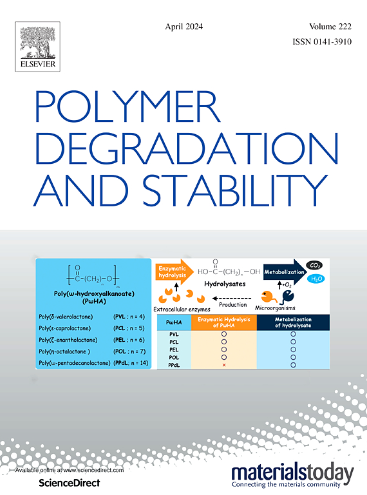The pyrolysis of polyvinyl chloride: Kinetic study and product evolution
IF 7.4
2区 化学
Q1 POLYMER SCIENCE
引用次数: 0
Abstract
This study investigates the thermal decomposition kinetics and mechanisms of Polyvinyl chloride (PVC). Kinetic parameters were determined using model-free methods, including Flynn-Wall-Ozawa (FWO) and Kissinger-Akahira-Sunose (KAS), as well as the model-fitting Coats-Redfern (CR) method. PVC was dehydrochlorinated in a fixed-bed reactor at 300–450 °C, followed by pyrolysis at 550 °C using pyrolysis gas chromatography-mass spectrometry (PY-GC/MS). In fixed-bed experiments, gaseous products and chlorine-containing species were characterized using a gas chromatograph equipped with thermal conductivity and flame ionization detectors (GC-TCD/FID), and oxygen bomb combustion-ion chromatography (OBC-IC). The structural evolution of char was examined through elemental analysis, Fourier transform infrared spectroscopy (FTIR), and Thermogravimetric analysis (TGA). The raw PVC was also pyrolyzed with Py-GC/MS at 300–550 °C to elucidate the reaction mechanism. Results revealed a two-stage thermal decomposition pathway for PVC, with the activation energy for the first stage (131.477 kJ·mol−1) was notably lower than that of the second stage (199.409 kJ·mol−1), indicating that defect structures initiate dehydrochlorination. At lower temperatures during fast pyrolysis, raw PVC undergoes dehydrochlorination, releasing HCl and forming short-chain conjugated polyenes. As temperature increases, the dehydrochlorination rate accelerates, forming longer conjugated polyene chains that rapidly cyclize and aromatize into bicyclic and tricyclic aromatic hydrocarbons. In contrast, the two-stage process, comprising low-temperature dehydrochlorination in a fixed-bed reactor followed by pyrolysis via PY-GC/MS, facilitates the development of a more extensively crosslinked structure during the initial stage. Upon subsequent thermal treatment, the crosslinked network undergoes further cracking and structural rearrangement, forming aliphatic hydrocarbons and more polycyclic aromatic compounds, particularly tetracyclic aromatic hydrocarbons.
聚氯乙烯热解动力学研究及产物演化
研究了聚氯乙烯(PVC)的热分解动力学和机理。采用Flynn-Wall-Ozawa (FWO)和Kissinger-Akahira-Sunose (KAS)等无模型方法以及Coats-Redfern (CR)模型拟合法确定动力学参数。PVC在固定床反应器中300-450℃脱氢氯化,550℃热解,采用热解气相色谱-质谱联用(PY-GC/MS)。在固定床实验中,使用配备热导和火焰电离检测器的气相色谱仪(GC-TCD/FID)和氧弹燃烧离子色谱(OBC-IC)对气态产物和含氯物质进行了表征。通过元素分析、傅里叶红外光谱(FTIR)和热重分析(TGA)研究了炭的结构演变。在300-550℃条件下,用Py-GC/MS对原料PVC进行了热解,以阐明反应机理。结果表明,PVC的热分解过程为两阶段,第一阶段的活化能(131.477 kJ·mol−1)明显低于第二阶段的活化能(199.409 kJ·mol−1),表明缺陷结构引发了脱氢氯化反应。在低温快速热解过程中,原料PVC发生脱氢氯化反应,释放出HCl,形成短链共轭多烯。随着温度的升高,脱氯化氢速率加快,形成更长的共轭多烯链,快速环化和芳构化成双环和三环芳烃。相比之下,在固定床反应器中进行低温脱氯化氢,然后通过PY-GC/MS进行热解的两阶段工艺,有利于在初始阶段形成更广泛的交联结构。经过后续热处理,交联网络进一步裂解和结构重排,形成脂肪族烃和更多的多环芳香烃,尤其是四环芳香烃。
本文章由计算机程序翻译,如有差异,请以英文原文为准。
求助全文
约1分钟内获得全文
求助全文
来源期刊

Polymer Degradation and Stability
化学-高分子科学
CiteScore
10.10
自引率
10.20%
发文量
325
审稿时长
23 days
期刊介绍:
Polymer Degradation and Stability deals with the degradation reactions and their control which are a major preoccupation of practitioners of the many and diverse aspects of modern polymer technology.
Deteriorative reactions occur during processing, when polymers are subjected to heat, oxygen and mechanical stress, and during the useful life of the materials when oxygen and sunlight are the most important degradative agencies. In more specialised applications, degradation may be induced by high energy radiation, ozone, atmospheric pollutants, mechanical stress, biological action, hydrolysis and many other influences. The mechanisms of these reactions and stabilisation processes must be understood if the technology and application of polymers are to continue to advance. The reporting of investigations of this kind is therefore a major function of this journal.
However there are also new developments in polymer technology in which degradation processes find positive applications. For example, photodegradable plastics are now available, the recycling of polymeric products will become increasingly important, degradation and combustion studies are involved in the definition of the fire hazards which are associated with polymeric materials and the microelectronics industry is vitally dependent upon polymer degradation in the manufacture of its circuitry. Polymer properties may also be improved by processes like curing and grafting, the chemistry of which can be closely related to that which causes physical deterioration in other circumstances.
 求助内容:
求助内容: 应助结果提醒方式:
应助结果提醒方式:


